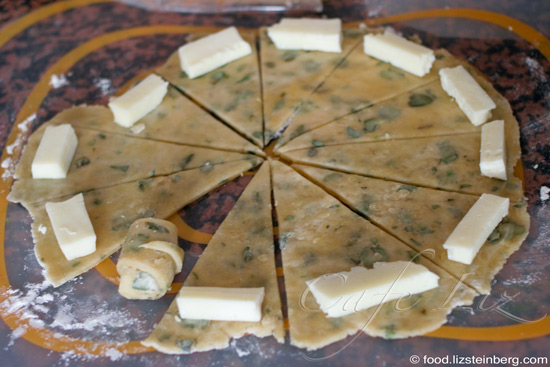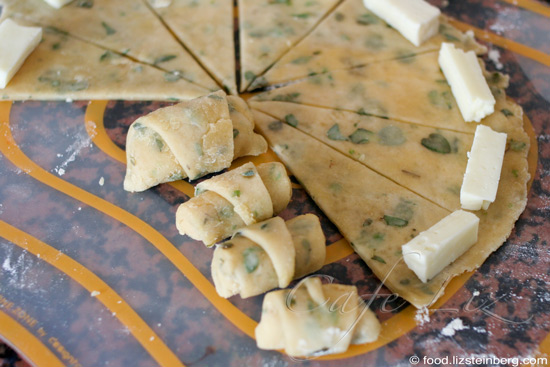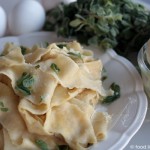
This is a different kind of sambusak. One I’d never seen before.
Sambusak is one of those ubiquitous snack foods around here, somewhere next to burekas. While these deep-fried or baked pockets of dough have a strong association here with Iraqi Jews, many of whom consider them an integral part of their culinary heritage, they’re made throughout the Middle East by people from a range of cultures. Not too surprising, no?
Sambusak are sold at every cheap bakery in town, making it easy to forget their rich cultural heritage. Fat and massive, you’ll find them stuffed with watery potato mash mixed with soup powder, watery cheese mash mixed with soup powder … well, you get the picture. Due to the nature of most cheap bakeries, this also makes it easy to forget that sambusak can be, well, good.
But a while ago, I had a sambusak revelation.
We were at my friend’s mother’s house in Nazareth for lunch. Every dish had been painstakingly prepared — stuffed grape leaves, stuffed eggplant, stuffed squash. And every one contained meat.
Eitan was happily eating salads, but my friend’s mother, Teres, is not one to leave any chance that a guest might go hungry. So she pulled some pastries out of the fridge and quickly fried them for Eitan. They were exquisite little croissants stuffed with gooey white cheese, with flakes of zaatar leaves rolled into the dough.
Sambusak, she said.
I’ve never seen sambusak like this, I told her. Usually they’re much bigger.
Sambusak, she said, as if to say, there is no sambusak but this.
I can’t tell you how common this style of sambusak is — whether it’s a Nazareth thing, or Teres’ own twist. I certainly haven’t found any record online of similar delights. Teres served them at a family wedding, both to honor the guests and to wow the neighbors. She was generous enough to share her recipe, or should I say, describe her recipe. I tried it at home and came up with some measurements.
The charm of these sambusak is threefold — first, their tiny size and croissant shape makes them into a delicate snack; second, their aromatic flavor comes from whole zaatar leaves as opposed to the dry, powdery zaatar spice mix that all too often seasons commercial pastries; and third, the filling is from firm chunks of cheese that becomes gooey when the pastries are cooked, not from some mashed paste. As a bonus, you can prepare them in advance and store them unbaked/unfried in the freezer, to serve to guests (or yourself) at a moment’s notice.
In short, it’s another level of sambusak.

A note on the ingredients: Teres used jibneh, a firm sheep cheese common in Arab towns (and whose name happens to mean “cheese” in Arabic). Since it’s harder to find in Tel Aviv, I used something similar from the Carmel Market that my cheese seller called “Iraqi cheese.” If you can’t find a firm, unaged sheep cheese, the closest alternative would be mozzarella.
Also, I used fresh zaatar (hyssop) leaves in the dough. An alternative would be fresh oregano. Dried whole zaatar leaves would be fine, but powdered zaatar spice mix would not.
For 36 small sambusak (3 cm long):
Dough:
- 2 cups flour
- 1/4 cup + 2 tablespoons olive oil
- 1/4 cup + 2 tablespoons water
- 3 tablespoons fresh zaatar (hyssop) leaves (not packed tightly; alternative: fresh oregano, or 1 tablespoon dry oregano or zaatar. Note: This is not the powdered zaatar spice mix.)
- 1/4 teaspoon salt
- 1/2 teaspoon yeast
Filling:
- 200 grams semi-hard unaged sheep cheese — jibneh or Iraqi cheese (alternative: mozzarella)
For frying:
- Enough oil for deep frying
Mix together all the ingredients for the dough. It will be shaggy and crumbly. Kneading, add enough water so that it comes together as a dough — about 1/4 cup plus 2 tablespoons. Form into a ball, cover and place in a warm place to rise until it doubles in size — about 1 1/2 hours.

Once dough has risen, knead two or three times to remove the air. Divide into three balls. On a floured surface, roll out one of the balls into a circle no more than 2 millimeters thick and ideally 1 millimeter thick. (It doesn’t need to be perfectly shaped.)

Cut the circle like a pizza into 12 wedges. Place a small block of cheese — about 1 inch by 1 centimeter by 1 centimeter — at the fat end of each wedge. Fold a bit of dough over the cheese, tuck in the sides and pinch if necessary so that the cheese is fully concealed, and roll up the dough toward the thin end, as if making a croissant.
Repeat for the rest of the slices and the rest of the dough.

At this point, you can fry the sambusak to eat immediately, or freeze them to eat later.
Heat oil to deep-fry the sambusak. (I do this in an iron wok, where the oil residue adds to the wok’s seasoning instead of making a gummy mess that later needs to be cleaned off.) The oil should be hot enough that bubbles immediately start coming off the sambusak when they’re dropped into it, but not so hot that they immediately turn a dark brown. Fry for 2-3 minutes until they are a light golden brown, remove with a slotted spoon onto a paper towel to absorb excess oil, and serve.
Alternately, you could bake them. I tried this only with the frozen sambusak: I stuck them in my toaster for about 12 minutes, until they browned lightly and the cheese was melted (my toaster does not actually have temperature settings). If you bake them fresh, they probably will be done much quicker.





